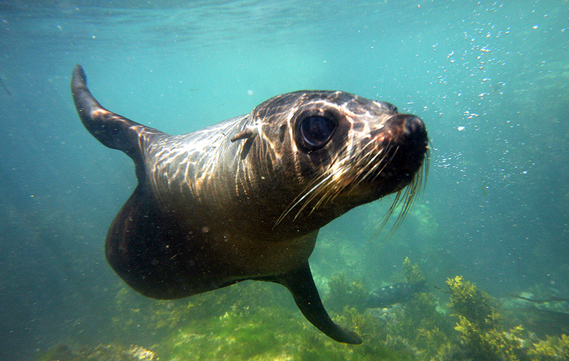NZ Fur Seals - Kekeno
(Arctocephalus Forsteri)
The New Zealand Fur Seal or Kekeno is widespread throughout the country however there are higher populations on the South Island. They are also also found on the Sub-Antarctic islands, the Chatham Islands, and the Subantarctic islands, as well as parts of Australia. Although Fur Seals were hunted to the brink of extinction in many areas by early European settlers, the population is now conservatively estimated to be 200,000, with an annual increase in numbers of 2%.
Fur seals and sea lions are distinguished from other seals by their external ear flaps and hind flippers which rotate forward, allowing them to move quickly on land.
New Zealand fur seals can be distinguished from sea lions by their pointy nose and smaller size. In New Zealand, fur seals also tend to be found on Rocky shorelines, whereas sea lions prefer sandy beaches.
This pointy-nosed seal has long pale whiskers and a body covered with two layers of fur. Their coat is dark grey-brown on the back, and lighter below; when wet kekeno look almost black. In some animals the longer upper hairs have white tips which give the animal a silvery appearance.
Adult females: maximum length 1.5 m, weight 30-50 kg.
Adult males: maximum length 2.5 m, weight 90-150 kg.
Fur Seals spend several days out at sea feeding (foraging trips may range 1-8 days) and then come ashore ('haul-out') for a day or so to rest and/or suckle their pups. Many people assume that the fur seals are sun-bathing when lying on the rocks, however they are merely resting. The seals have a thick fur coat, underneath this they have a thick layer of blubber. These keep them well insulated at sea but when they come ashore to rest they are vunerable to overheating, so are forced periodically to enter the water to cool down (this is generally when you would be swimming with them).


There are several colonies of Fur Seals around Kaikoura Peninsula and breeding occurs in some of these. Females are sexually mature between 4 and 6 years old, and give birth to a single pup more or less every year until death at 14-17 years. Males become sexually mature at 5-6 years, but are unlikely to be socially mature (able to defend a breeding territory) for at least another 3 years. Mating occurs about a week after the birth of the pups (mid-November to mid-January), but they have delayed implantation. The egg is fertilised, but it does not implant in the uterine wall for another 3 months or so. The gestation period is therefore 9 months, even though the female is "pregnant" for 51 weeks of each year.
Pups are suckled for about 300 days and start to feed on solid foods before weaning. They spend a large proportion of time playing with other pups and with objects such as seaweed and reef fish. It is possible that they attain important skills for later life such as foraging, anti-predator behaviour and also social behaviour at this stage.

Some small males who are not yet large enough to defend a breeding territory employ a cunning strategy in order to mate. They are called 'satellite males' because they spend their time at the edge of the dominant territories. When the dominant male is involved in a territory dispute with another large male the small 'satellites' race in, mate as quickly as they can and race out again!
New Zealand Fur Seals do most of their feeding at night time in our offshore waters where they feed mainly on squid, red cod, hoki, and lantern fish. Most of their prey have a vertical migration through the water column; they come near the surface at night and sink back to the depths during day time. It appears that the seals follow this migration when foraging. The deepest dives occur around dusk and dawn and these are likely to be searching dives, where the seals are looking for prey patches. They have been recorded diving deeper than 238m and for as long as 11 minutes, however, most dives are considerably shorter, averaging 1-2 minutes.


